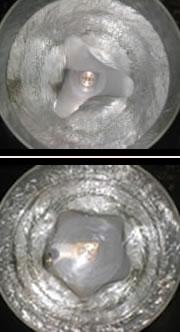 As a bucket of water speeds up, the hole changes shape from a three-sided star to a pentagon.Credit T.R.N. Jansson
As a bucket of water speeds up, the hole changes shape from a three-sided star to a pentagon.Credit T.R.N. JanssonBizarre geometric shapes that appear at the centre of swirling vortices in planetary atmospheres might be explained by a simple experiment with a bucket of water.
Researchers at the Technical University of Denmark in Lyngby have created similar geometric shapes (holes in the form of stars, squares, pentagons and hexagons) in whirlpools of water in a cylindrical bucket1. The shapes appear easily enough once the bucket is spinning at a rate of one to seven revolutions per second, they say.
Tomas Bohr and colleagues made plexiglass buckets, 13 and 20 centimetres across, with metal bottoms that could be rotated at high speed by a motor. They filled the bucket with water and spun the bottom to whip up the liquid into a whirlpool that rose up the sides of the container.
This set-up is very similar to the rotating bucket that Isaac Newton used in the seventeenth century to investigate centrifugal forces.
The researchers found that once the plate was spinning so fast that the water span out to the sides, creating a hole of air in the middle, the dry patch wasn't circular as might be expected. Instead it evolved, as the bucket's spin sped up, from an ellipse to a three-sided star, to a square, a pentagon, and, at the highest speeds investigated, a hexagon.
In a spin
The apparatus needed to see this strange effect is so simple that it seems surprising that it has never been reported before. Bohr suggests that either no one was looking for it, or they simply didn't spin water fast enough.
Harry Swinney, a specialist in pattern-forming fluid flows at the University of Texas at Austin, says the new observation is roughly in line with what one might expect. At high enough rotation speeds, he says, a fluid will always experience some flow instability that creates a symmetrical structure.
Similar polygonal shapes have been reported in gigantic, vortex-like flows in the atmosphere of our planet and others, as well as in the eye of a hurricane2. And an immense, hexagonal-shaped vortex was spotted by the Voyager spacecraft at the northern pole of the gas-giant planet Saturn3.
ADVERTISEMENT
These natural structures have never been fully explained. Could they be produced by the effect observed by the Danish team? "I expect that similar conditions might apply in these atmospheric flows," says Bohr. But he admits that at this stage he doesn't understand the pattern-forming process well enough to be sure of the comparison.
Swinney, meanwhile, thinks that the process is unlikely to apply to large-scale flows such as that on Saturn, but might be relevant to smaller-scale phenomena such as tornadoes.
Visit our whirlpoolsrevealed.html">newsblog to read and post comments about this story.
